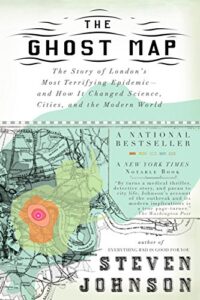 A friend is reading Steven Johnson’s The Ghost Map: The Story of London’s Most Terrifying Epidemic–and How It Changed Science, Cities, and the Modern World – and she’s been regaling me with stories of toshers, pure-finders, mudlarks and the sewers of Victorian London.
A friend is reading Steven Johnson’s The Ghost Map: The Story of London’s Most Terrifying Epidemic–and How It Changed Science, Cities, and the Modern World – and she’s been regaling me with stories of toshers, pure-finders, mudlarks and the sewers of Victorian London.
Here’s how the book begins:
It is August 1854, and London is a city of scavengers. Just the names alone read now like some kind of exotic zoological catalogue: bone-pickers, rag-gatherers, pure-finders, dredgermen, mud-larks, sewer-hunters, dustmen, night-soil men, bunters, toshers, shoremen. These were the London underclasses, at least a hundred thousand strong. So immense were their numbers that had the scavengers broken off and formed their own city, it would have been the fifth largest in all of England. But the diversity and precision of their routines were more remarkable than their sheer number. Early risers strolling along the Thames would see the toshers wading through the muck of low tide, dressed almost comically in flowing velveteen coats, their oversized pockets filled with stray bits of copper recovered from the water’s edge. The toshers walked with a lantern strapped to their chest to help them see in the predawn gloom, and carried an eight-foot-long pole that they used to test the ground in front of them, and to pull themselves out when they stumbled into a quagmire. The pole and the eerie glow of the lantern through the robes gave them the look of ragged wizards, scouring the foul river’s edge for magic coins. Beside, them fluttered the mud-larks, often children, dressed in tatters and content to scavenge all the.waste that the toshers rejected as below their standards: lumps of coal, old wood, scraps of rope.
Above the river, in the streets of the city, the pure-finders eked out a living by collecting dog shit (colloquially called “pure”) while the bone-pickers foraged for carcasses of any stripe. Below ground, in the cramped but growing network of tunnels beneath London’s streets, the sewer-hunters slogged through the flowing waste of the metropolis. Every few months, an unusually dense pocket of methane gas would be ignited by one of. their kerosene lamps and the hapless soul would be incinerated twenty feet below ground, in a river of raw sewage.
The scavengers, in other words, lived in a world of excrement and death.
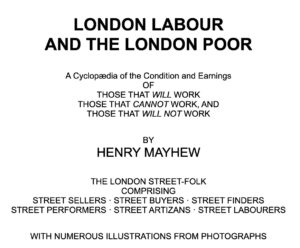 The underworld and street life of the scavenger army was meticulously documented by Henry Mayhew whose London Labour and the London Poor (1851) is a detailed compendium thick with data, anecdote, and detailed descriptions and interviews.
The underworld and street life of the scavenger army was meticulously documented by Henry Mayhew whose London Labour and the London Poor (1851) is a detailed compendium thick with data, anecdote, and detailed descriptions and interviews.
Here he is on the collectors of dog shit – the pure-finders. First he informs us that:
Dogs’-dung is called “Pure,” from its cleansing and purifying properties.
The pure-finders meet with a ready market for all the dogs’-dung they are able to collect, at the numerous tanyards in Bermondsey, where they sell it by the stable-bucket full, and get from 8d.to 10d.per bucket, and sometimes 1s.and 1s.2d.for it, according to its quality.
But not all dog shit is top quality. And sometimes a little cheating took place
The “dry limy-looking sort” fetches the highest price at some yards, as it is found to possess more of the alkaline, or purifying properties; but others are found to prefer the dark moist quality. Strange as it may appear, the preference for a particular kind has suggested to the finders of Pure the idea of adulterating it to a very considerable extent; this is effected by means of mortar broken away from old walls, and mixed up with the whole mass, which it closely resembles; in some cases, however, the mortar is rolled into small balls similar to those found. Hence it would appear, that there is no business or trade, however insignificant or contemptible, without its own peculiar and appropriate tricks.
If picking the stuff up is a foul enough profession, think of the tanners whose job it was to rub the pure into the hide by hand as one of several processes of production. In a horse-powered world – before the invention of synthetics – leather was an important product for footwear, clothing, bookbinding, and the saddlery and harness for all those horses. And in this scavenging economy, nothing goes to waste. Everything has a value to someone somewhere and everything is recycled. Including the night soil and sewage of the streets.
“Out of the London mud come the London cabbages.”
Here are two descriptions of Victorian London:
First Impressions: An American in London
After a short journey
through country divided by
hedges into a green and gold
checker-board; thatched roofs disappear,
and chimney-pots take their place and
flourish until you come to
the Thames,
where black barges in mid-stream
wait for the muddy tide to turn,
between banks of masts
and smokestacks; then
the Gothic buildings
of Parliament, and “Big Ben,”
and Charing Cross Station; and
in another moment
you are in London,
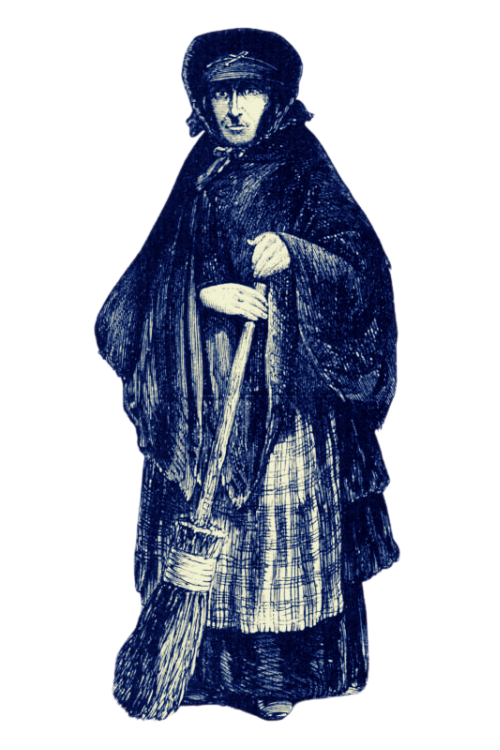 riding through the never-ending
riding through the never-ending
restlessness of its streets
in a cab that you can afford, with
your hat-box safe by your side and
your trunk up by the driver,
and London with its history
on all sides of you,
its wooden streets and
polished side-walks and bright
shop windows, and at every corner
small sweeps and big policemen,
providing clean and safe crossing,
while push-carts dodge
in and out between
steaming bus-horses and hansom cabs.
This is always my first impression of London.
– -Charles Dana Gibson
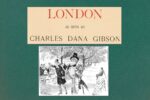 That’s the opening two sentences of Gibson’s London from 1897. All very tidy, orderly and civilized. A prosperous middle and upper-class London. Where are the fog and filth? The vice and violence?
That’s the opening two sentences of Gibson’s London from 1897. All very tidy, orderly and civilized. A prosperous middle and upper-class London. Where are the fog and filth? The vice and violence?
Mayhew has lots of information about the lives of those street sweepers and their relations with the police. And while he was often lyrical in his descriptions – and had a remarkable eye for descriptive detail – he was a reformer who saw the skull beneath the skin, the poverty and squalor behind the city and town facade. Here are his words about London from afar, and closer up. (As with the Gibson, I’ve taken the liberty of setting them out.)
From a letter in the Morning Chronicle from Friday, October 19, 1849.
London
Those who have only seen London
in the daytime, with its flood
of life pouring through its arteries to its
restless heart, know it not
in its grandest aspect.
It is not in the noise and roar
of the cataract of commerce
pouring through its streets, nor in its forest
of ships, nor in its vast docks
and warehouses, that its true
solemnity is to be seen.
To behold it in its greatest sublimity, it must
be contemplated by night, afar off,
from an eminence. The noblest prospect
in the world, it has been well said,
is London viewed from the suburbs
on a clear winter’s evening. The stars
are shining in the heavens, but there is
another firmament spread out below,
with its millions of bright lights
glittering at our feet.
Line after line sparkles,
like the trails left by meteors, cutting
and crossing one another till
they are lost in the haze of the distance. Over
the whole there hangs a lurid cloud,
bright as if the monster city
were in flames, and looking afar off
like the sea by night, made phosphorescent
by the million creatures dwelling within it.
At night it is that the strange anomalies
of London are best seen. Then,
as the hum of life ceases
and the shops darken,
and the gaudy gin palaces thrust
out their ragged and squalid crowds,
to pace the streets, London
puts on its most solemn look of all.
On the benches of the parks,
in the nitches of the bridges, and
in the litter of the markets, are huddled together
the homeless and the destitute.
The only living things that haunt
the streets are the poor wretches who
stand shivering in their finery,
waiting to catch the drunkard
as he goes shouting homewards. Here
on a doorstep crouches
some shoeless child, whose
day’s begging has not brought it
enough to purchase it even the twopenny
bed that its young companions
in beggary have gone to. There,
where the stones are taken up
and piled high in the road, and
the gas streams from a tall pipe
in the centre of the street
in a flag of flame – there,
round the red glowing coke fire,
are grouped a ragged crowd smoking
or dozing through the night beside it.
Then, as the streets grow blue with
the coming light, and the church spires
and chimney tops stand out against the sky
with a sharpness of outline that is seen
only in London before its million
fires cover the town with
their pall of smoke – then come
sauntering forth the unwashed poor,
some with greasy wallets on their back,
to hunt over each dirt heap, and eke
out life by seeking refuse bones or stray
rags and pieces of old iron. Others,
on their way to their work, gathered
at the corner of the street round
the breakfast stall, and
blowing saucers of steaming coffee
drawn from tall tin cans, with
the fire shining crimson through
the holes beneath; whilst already
the little slattern girl, with
her basket slung before her, screams
watercresses through the sleeping streets.
And Mayhew follows this with a very pointed commentary about home and Empire and the disparities of wealth and income.
Yet who, to see the squalor and wretchedness of London by night, would believe that twenty-nine only of the London bankers have cleared through their clearing-house as much as nine hundred and fifty-four million pounds sterling in one year, the average being more than three millions of money daily – or that the loans of merely one house in the City throughout the year exceed thirty millions? Who could have visited the Rookery of St. Giles’s as it existed but a few months back, and have seen the unutterable abominations of this retreat of wretchedness, this nest of disease, at once the nursery and sanctuary of vice – where in one house alone, Mr. Smirke tells us, were huddled together eleven men, thirteen women, and thirty children – where as many as sixty of the foulest of the London lazzaroni often sleep in the same abode – who could witness this want and wretchedness, and yet believe that this country is “the ban for the whole world,” as the late Mr. Rothschild called it in 1832; or that “all transactions in India, in China, in Russia, and indeed every other empire, are guided and settled in this country”?
Maybe progress is an illusion.
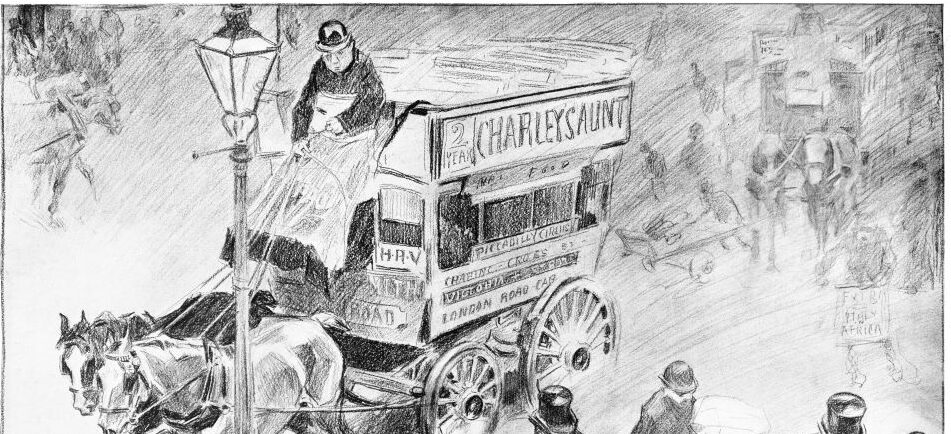

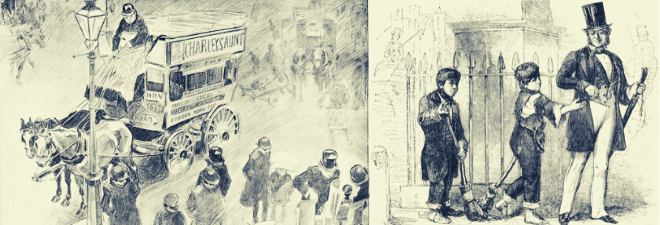
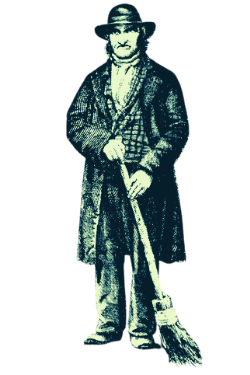


As you know I have always liked cabbages…good recycling material they are too.
Another great account, this time of lives we rarely hear about but which kept the City going. Very pertinent to today. Like it or not, and I fear many won’t, our ways of exploiting the world to the disbennefilt of the planet and especially the unprivileged have to change…change for the better tho many may not see it yet.
Your extracts are fascinating. I’m longing to read more of all of them, but am definitely going to look out for The Ghost Map.
Here’s a longer excerpt from the start of The Ghost Map: https://www.penguin.com/ajax/books/excerpt/9781594482694#:~:text=Dickens%20began%20his%20last%20great,for%20stealing%20from%20a%20corpse. It has convinced me to get the book and read the rest. Mayhew is available online (Gutenberg) and is one of those books packed with fascinating details and data.
This is true. Nothing like a good cabbage.
In addition to feeding cabbages it was also – according to Mayhew – exported to the “sugar-growing colonies” as fertilizer.
Gruesome conditions!
Gruesome indeed. A world of no social safety nets, huge wealth inequality and so many living in abject squalor. Right there at the heart of the mighty British Empire!
Yet it was in some ways the perfect ecosystem. Nothing was wasted. everything was recycled. every part could be used and reused for something. And Mayhew writes extensively about how all the pieces fit together.
Well it seems that we are not so far away from that time as we like to imagine. The present challenges are revealing how hungry (now euphemistically called food insecure) many Americans are right now. And so many risk evictions and will end up in cars or on the street.
You are so right. We are living in a time when the incompetence and cruelty of the tRumpian GOP misadministration are matched only by its corruption and criminality.
Straight out of Dickens!
Yes. Very. “Our Mutual Friend” opens with father-daughter tosher team working the river. And that parallels between the characters that Mayhew meets, and the ones Dickens creates, are many.